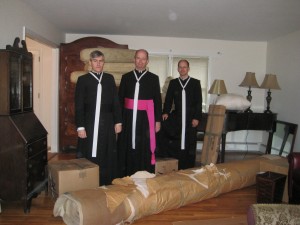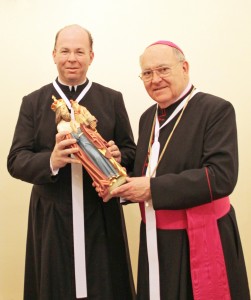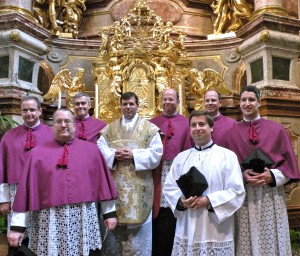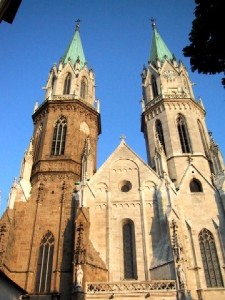Canons Offer New Way of Life for American Priests, Part Two

Fr. Elias Carr, Fr. Daniel Nash, and Fr. Bruno Semple of the Canons Regular of St. Augustine just landed in New York. They took a break from unpacking for this exclusive interview.
If you missed Part One of this interview with the Canons Regular of St. Augustine, you can find it here . In Part Two, the Canons talk about their return to the U.S. and how you can support their mission.
Q: Did you think you’d ever come back to serve a parish in the U.S?
Fr. Daniel: I always imagined that, someday, there would be an American house. For most of my time in Austria, however, I was far more concentrated on the parochial duties I had as Pastor of the parish of St. Leopold in Donaufeld, as well as on doing what I could to encourage the common life in the House.
Fr. Elias: Absolutely. Although each man’s vocation to Klosterneuburg is personal and therefore its relationship to founding a community in America differs, I always maintained the hope and the expectation that we would return to America to introduce our charism, to support priests and care for the laity.
Fr. Bruno: I always hoped to come back. That was one of my reasons for joining. I wanted this form of priestly life, and to eventually bring it back to the States. But when I first joined I thought that it would happen very quickly. For me it took eight years, much longer than expected.
I don’t think that it was a bad thing that it took so long. It takes time to become part of a community and learn a new way of life. We were able to become more settled in our identity as religious priests the longer we were there. If we had started this daughter house too soon, it wouldn’t have gone as well as it is now.
Q: How did you get the opportunity to return to the U.S.?

Fr. Daniel Nash, Prior of the Canonry of St. Leopold with the Most Reverand Bernhard Backovsky, Provost of the order.
Fr. Daniel: About three years ago, the Provost (Superior) of the Abbey gave the Americans permission to send out letters to bishops in the States to see if there was any interest in having a small foundation of Canons come to their diocese. After a lengthy process, we decided to accept the very generous offer of Bishop Murphy, the Bishop of the Diocese of Rockville Centre, New York.
Fr. Elias: Providence of God. The story is one of serendipity and kindness. We had lots of people praying for us, especially in the Society of St. Leopold, a group of lay benefactors who have accompanied us spiritually on this project. Many priests recommended us to bishops too. We began in July 2008 in earnest in our search with the blessing of our Provost, Abbot-Primate Bernhard Backovsky.
Our ideal destination included space for a growing community and for guests as well as sufficient work for a group of priests. Of course, many dioceses could not accommodate us and some were flat out not interested. Of those that were, we eventually accepted the proposal of Bishop Murphy because he offered us a package which best suited our needs and at the same time clearly benefited our future diocese. We are most grateful to him and have been warmly received.
Q: Do you think the religious climate in the U.S. has changed since you left?
Fr. Daniel: Americans are still more open to religion and the role of religion and faith in public life than most Europeans, although the tide of secularism has eroded much of that even here. The problem of “belonging without believing,” that is, of seeing membership in a church not as a matter of personal faith and commitment, but rather a social or cultural matter has a stranglehold on much of Europe.
Americans still, it seems to me, have a stronger sense of the need to believe in order to belong. This is hopeful, but without care and support, would like all things without grace, eventually fall apart. Nevertheless, the possibilities for growth in the U.S. are great, and we are very happy to be back home.
Fr. Elias: Having only been back in the States a few months, it is hard for me to say. Clearly the U.S. has been through a difficult decade: terrorism, wars, scandal, economic dislocation, disordered political leadership and a toxic culture.
Further unwanted evidence for our decline as a society appeared upon our arrival in our new parishes in Glen Cove, which more or less coincided with the cowardly decision of the New York State Senate to deconstruct marriage and allow same-sex couples to be treated as if they were really married. So, we are in the right place. There is a great need for the Gospel.
Fr. Bruno: It’s hard for me to judge the U.S. as a whole. I am from Spokane and now live in New York for the first time. That in itself is a big difference in cultures. But I can tell you that Americans are on average much more religious than the Austrians. Austrians come out of a state-sponsored church history and even though there is now a separation of church and state, the mentality is still the same. For example, the church tax is the main source of revenue for the Catholic Church, not the collection plate on Sunday.
As such, there is a lot of resentment against the Church for the times when people suffered under such a cozy relationship. It is very hard to find someone who loves the Church and sees it as the Mystical Body of Christ. For many, the Catholic Church is a “them“ and not an ”us.“ In Vienna, only 4% of Catholics go to Mass on any given Sunday, as opposed to 39% here. In the U.S., I think that a lot more people love the Church and see the spiritual realities more clearly and identify with her teaching and mission.
Q: What does your order hope to accomplish by coming to the U.S.? It sounds like you’re quickly becoming organized and could eventually expand.
Fr. Elias: The American foundation has a number of aims. First, to introduce our charism to the U.S.; there are several foundations of canons here, but none from our venerable tradition. We believe that our way of life as canons has much to offer priests by way of example and support. Second, we hope to attract vocations to assist us in our mission in New York as well as offering the possibility of serving in Austria or Norway, and possibly elsewhere someday. Third, we want to support Bishop Murphy and the diocese of Rockville Center by not only caring for our two excellent parishes, St. Patrick and St. Rocco, but also by building up a center for the promotion of authentic liturgical development and spiritual renewal.
Ultimately, the scope and magnitude of our pastoral endeavors depend on God’s plans for this project. He brought us back to America — with the powerful intercession of St. Leopold, the benefactor of our Abbey — despite many obstacles. Indeed, some might even say it is a miracle that we are here at all.
Q: In terms of religious life, you offer a unique blend of parish life and community. How do men in discernment respond to that? Is it appealing?
Fr. Daniel: The canonical life as we have inherited it from Klosterneuburg stands at a crossroads, so to speak, between the life of the diocesan clergy and religious life. We see ourselves as being rather close to the local clergy, partly because many of the Americans who entered the community entered as already ordained priests, having served as diocesan priests. That we are so thoroughly involved in parochial work, and especially here in our new foundation, actually living in one of the parishes we serve, and facing many of the same challenges as the local clergy.
While there are certainly other religious orders whose members are involved in parochial work, the bond between us and the diocesan clergy is perhaps a bit stronger, since we have no particular charism as Canons other than the living out of the priesthood in common. While Canons might teach, or do any other type of ministry, our foremost vision is that of the priesthood lived in common.
Fr. Elias: The distinctive character of our way of life is that we are priests whose common life supports and shapes our pastoral ministry. We profess vows of obedience, chastity and common property without private property. The community looks after each member, and each member looks after the community. We share all that we have, and all that we are, so as to encourage one another on our way to God.
It is a mature religious life that permits a certain scope for each individual and his personality, while at the same time calling each man to a higher, more sacrificial, more generous, less selfish way of being a man.
Whether this is appealing to Long Islanders or other Americans is already clear: Fr. Daniel and I wandered far and wide from our homes on Long Island, only to have the Lord bring us to Glen Cove. Americans, moreover, make up a significant portion of our community. But in the end, it is up the Lord of the Harvest. He will send us the vocations that He sees fit.

Eight Americans of Klosterneuburg, from left to right: Fr. Clemens, Fr. Josef and Fr. Elias (2002), newly-ordained Fr. Maximilian (2003), Fr. Daniel, the Prior of the Canonry of St. Leopold (2004), Fr. Ambros (2009), Fr. Bruno (2003) and Fr. Gabriel (2006)
Fr. Bruno: We have had a number of men contact us over the years in Austria specifically because we have both community life and parish ministry. For different reasons, most of those who looked at us did not join. But there were some who did join and of the 11 Americans who joined, there are now eight in the community not to mention the numbers of men from all over Europe who have come and joined. Many men have put off following the calling that they felt specifically because diocesan priests often live alone.
Q: Fr. Elias, you are the pastor of an Italian parish. Does that mean you say some Masses in Italian?
Fr. Elias: I am pastor of the Church of St. Rocco; the Italian national parish for the diocese of Rockville Centre. In addition to holding a Sunday Mass in Italian, there are numerous other Masses, confessions, and devotions in Italian.
Besides serving the local Italian-American community in Glen Cove, the parish provides a home for numerous statues of Our Lady or other saints, who were honored in the hometowns of different groups of Italians. St. Rocco is a place of refuge for these groups, whose patrons have lost their homes in other churches in the New York area. The most famous expression of our Italian heritage, blended with our immigrant experience in America, is the “Best Feast in the East,” the feast of St. Rocco, that takes place during the last week of July.
Q. And Fr. Daniel and Fr. Bruno, you are at a parish that is historically Irish?
Fr. Daniel: St Patrick’s parish, the oldest parish in the Diocese of Rockville Centre, has a remarkable diversity of cultures in its makeup: originally an Irish parish, and still boasting a strong Irish-American component. The parish is really “catholic” in the sense of universal. A considerable percentage of the parishioners come from Spanish-speaking countries – almost all of the nations of Central and South America are represented.
Q: Do the Canons have a distinct type of attire they wear to distinguish them from other orders?
Fr. Daniel: The “funny long white tie” is the most striking element of our habit. It is a sarozium, which comes from Latin for the “sacred rochet.” The rochet was always a part of our habit: a rochet is much like a surplice, which is the white garment most often seen on altar boys over the black cassock, but the rochet, with narrower sleeves than a surplice and usually adorned with lace, is reserved to bishops, cardinals, and canons. For us, it was a sign of our commitment to the Liturgy of the Hours.
Over the centuries, however, wearing a white garment with lace all the time became rather impractical. So the rochet morphed into the present version, a long narrow strip of heavily starched white linen, hanging in front and in back. It is unique to canons. Even if the sarozium occasionally gets caught in something or crunched or crushed, it serves as a visible reminder of our call to constant prayer.
Fr. Elias: The canonical habit originally distinguished monks and canons. The former wore black wool, the later taking the example of the Levitical priests, wore white linen. In the course of the long history of the order, canons developed many variations of the habit. Ours at Klosterneuburg more or less reflects a form adopted in the 18th century. At that time, the white habit was replaced with black wool, and the rochet was replaced by our distinctive sarozium (sacrum rochettum).
Only three houses of the Austrian Congregation still wear the sarozium. While our habit is not, therefore, unique, it is most unusual and seldom seen outside of our places of religious life.
Q: Are there Canonesses?
Fr. Daniel: Very few, sadly. Klosterneuburg was, as many abbeys were, for a period of its history a “double monastery.” An order of Canonesses was housed there, although they had no interaction with the Canons.
Fr. Elias: Canonesses exist in other branches of the canonical family, but they are few in number. If God wishes, perhaps there will be more Canonesses in the future. Canonesses are as nuns are to monks; a female branch of the Canonical Order.
Q: How can people support your mission?
Fr. Daniel: First of all, with prayers for future vocations and prayers for us now. We would not be here had it not been for constant support in prayer of so many people, some of whom we don’t even know or are only now finding out about!
This baby, now born, needs a great deal of care and attention, and of course, a college fund! Any future growth and expansion will depend on our being financially responsible.
Since we are the first Canons Regular from our tradition in the United States, we needed to establish a presence here, both in Canon and civil law. We established two not-for-profit corporations, Canons Regular of Saint Augustine (USA), Inc. and The Canonry of Saint Leopold, Inc. The former is an umbrella organization, concerned with the establishment of the Canonical life in America, and hopefully, in more places some day. The second is concerned with the day-to-day operations of our new foundation. Both have tax-exempt status, are able (and thankful) to receive donations of any kind, and can provide information for tax purposes. Donations can be sent to The Canonry of Saint Leopold, 235 Glen Street, Glen Cove, NY 11542.
We welcome the interest of new and old friends. The website established at the beginning of the “American Project” is a great source of information.
For our House here, Fr. Elias recently established a Facebook page so that we can easily share a bit of the adventure. Questions, requests for prayers, and inquiries about vocations can be directed to: (Enable Javascript to see the email address).


